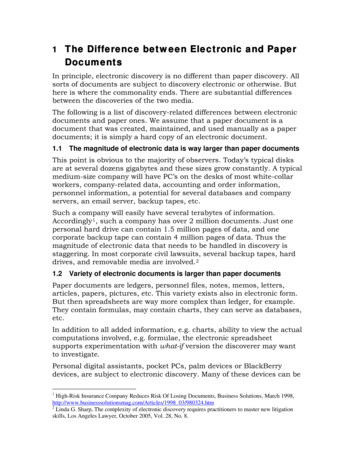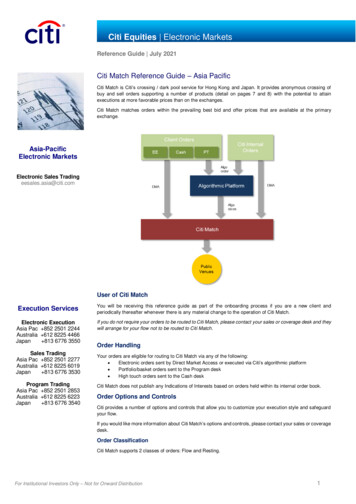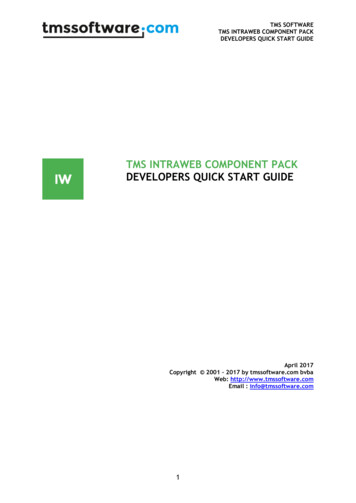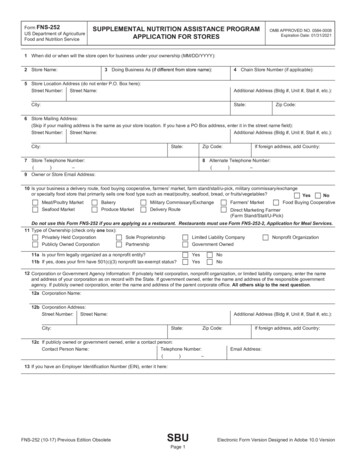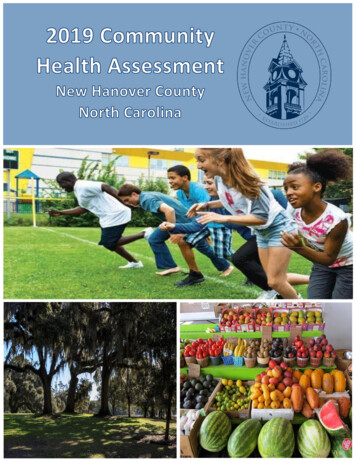
Transcription
An electronic version of this report is available on theNew Hanover County Public Health /
Dear Family, Friends and Neighbors,For the past 140 years, New Hanover County Public Health has led thecharge to promote health, prevent disease and protect our environment.It would be immeasurable to calculate the difference that Public Healthhas made in the quality of life of New Hanover County residents andvisitors over that time. The one constant has been our determination toensure excellent health; a common denominator that can create a vibrantand prosperous community.This Community Health Assessment (CHA) is presented to you as a livingdocument used for identification and prioritization of significant healthneeds in New Hanover County. The goal is to offer a meaningful understanding from the identified set ofprimary and secondary data that will continue to enhance the quality of life in our community.The CHA includes information about the current health of the community and the resources available toimprove lives. It will be a living document that will address not only the individual risk factors that createvulnerability to disease but the social determinants such as housing, food insecurity and access to carethat create discrepancies from the lack of equity in our population. We know these and otherdeterminants have as much or more impact towards a populations health than ever before. Thefoundation of Public Health has and will continue to be the continued understanding for the trends inthe community’s health, building partnerships for the wellbeing of our population and ensuring thatthose partners are working together to become part of the capacity to make good health happen.As you read through the CHA, I invite you to be part of the team that addresses the ever-present healthneeds in our community. I believe everyone can play an active role in the betterment of theircommunity and create an environment supportive for prosperity. As, director for Public Health in NewHanover County I ask you to join me in tackling the health and socioeconomic disparities that impedeour community’s health. Together we can make a difference.Sincerely,Phillip E. TartePhillip E. Tarte, MHANew Hanover County Public Health Director
TABLE OF CONTENTSChapter1 : Introduction & Background . 1Chapter 2: New Hanover County Description . 2Snapshot of New Hanover County . 2Chapter 3: Primary Health Data Collection & Analysis . 5CHA Survey Results . 6Chapter 4: Secondary Data Analysis . 9Social Determinants of Health . 15Chapter 5: Community Concerns & Priorities . 22Prioritization Session. 22Next Steps . 22Chapter 6: Prevention & Health Promotion . 23Chronic Disease . 23Drug Misuse . 24Environmental Health Exposure . 27References . 28Within DocumentAppendix A – New Hanover County Community SurveyAppendix B – New Hanover County Public Health Strategic Plan 2018-2021Appendix C—Northside Community Health and Well-Being Survey
ACKNOWLEDGMENTSAgencies and Community Partner Collaborations:Blue Ribbon CommissionCape Fear Community CollegeCoastal Carolina Health AllianceCoastal HorizonsCommunity Care of the Lower Cape FearFeast Down EastMedNorth Health CenterNAACP, New Hanover County ChapterNew Hanover County Cooperative ExtensionNew Hanover County Department of Social ServicesNew Hanover County PlanningNew Hanover County Public HealthNew Hanover County SchoolsNew Hanover County Senior CenterNew Hanover County Sheriff’s DepartmentNew Hanover Regional Medical CenterSEAHECSmart Start of New Hanover CountyTrilliumUnited WayUniversity of North Carolina Wilmington (UNCW)WAVE TransitWilmington Chamber of CommerceWilmington Housing AuthorityCommunity Health Assessment (CHA) Advisory CommitteeThe New Hanover County Public Health Department’s Health Promotion Division, in collaboration withthe UNCW School of Nursing, functioned as an advisory committee in the CHA process. The NHCPH’sHealth Promotion staff also served as project facilitators of the CHA process. The advisory committeereviewed CHA materials, helped to identify resources and support in the community, compiled thesecondary and primary data, and assisted in the interpretation of data. Community meetings were heldto provide the committee with community input and assistance.
CHAPTER 1: INTRODUCTION & BACKGROUNDThe community health assessment (CHA) is an analysis of the health status of the community in contextwith the community’s economic, social and environmental climate. This report will be an importantresource for the community to improve the health and well-being of the people in New Hanover County.The purpose of the CHA is to identify factors that affect the health of a population and determine theavailability of resources within the community to adequately address these factors. Throughcollaborative efforts forged among community leaders, public health agencies, businesses and hospitals,the community can begin to answer key questions such as (a) “What are our problems?” (b) “Whatfactors contribute to these problems?”, and (c) “What resources are available in the community toaddress these problems?”.In a community based assessment, community members take the lead role in forming partnerships,gathering health related data, determining priority health issues, identifying resources, and planningcommunity health programs. In this framework, the assessment process starts with the people who livein the community. The community has the primary responsibility for determining the focus of theassessment activities at every level, including collection and interpretation of data, evaluation of healthresources, identification of health problems, and development of strategies for addressing theseproblems.1 Page
CHAPTER 2: NEW HANOVER COUNTY DESCRIPTIONLocated in southeastern North Carolina and established in 1729, New Hanover was formed from CravenCounty, one of three original counties in North Carolina. New Hanover County is the second smallestand one of the most densely populated counties in the State. The County’s land area totalsapproximately 220 square miles; of this total, over 21 square miles consist of water and wetlands. [1]The current population of New Hanover County is approximately 232,274; a 14.6 percent increase overthe 2010 U.S. Census of 202,667. [2]New Hanover County was named in honor of English King George I, who also ruled the Kingdom ofHanover, Germany. The English royal family was called the House of Hanover. For over 250 years, theNew Hanover County seat has been the port city of Wilmington located along the Cape Fear River.New Hanover County is home to four incorporated municipalities: Wilmington, Carolina Beach, KureBeach, and Wrightsville Beach. The County’s beaches provide miles of unspoiled natural beauty and arethe area’s most popular tourist attractions. The surrounding terrain is low lying, with an averageelevation of less than 40 feet. The highest elevation is approximately 75 feet above sea level. The city’sriverbanks boast a major container seaport, a charming historic district, Battleship North Carolina,Gothic churches and riverfront shops. To the south lies the North Carolina Aquarium, Fort Fisher andmiles of unspoiled beaches.[1]Although Wilmington is the largest city in southeastern North Carolina, it retains a small townatmosphere. Visitors are treated hospitably and immediately sense the strong community pride.Wilmington is the cultural, medical, educational and economic center for the southeastern region of thestate. The city is rich in historical significance and in the 20th century, the city’s economy shifted fromriver commerce to the railroad. Its inviting business climate has attracted giants like G.E., DuPont,Corning, PPD, Verizon and a major film studio, in addition to smaller, high-tech firms and corporations.Wilmington is known for historic preservation annual events, such as the North Carolina Azalea Festivaland Riverfest. All of this adds to the pleasant lifestyle that growing numbers are enjoying in NewHanover County.Snapshot of New Hanover CountyFrom 2010 to 2018, New Hanover County has seen an increase in population of about 15 percent whileNorth Carolina only saw an increase of about 9 percent. New Hanover County has a population of232,274 people. When broken down by ages, New Hanover County has a higher percentage of 65 andolder residents than North Carolina (17.7% compared to 16.3%).[2]New Hanover County has a higher percentage of residents 25 and older who are high school graduates(92.9% compared to 87.4%) and a higher percentage of those 25 and older who have a bachelor'sdegree or higher (39.3% compared to 30.5%) compared to the state.[2]In 2018, New Hanover County and North Carolina shared about the same percentage of persons living inpoverty (15.3% compared to 14%).[2]From 2014-2018, the median value of owner-occupied housing units in New Hanover County was 233,700 compared to North Carolina average of 165,900. In 2018, the median household income forNew Hanover County was 52,716, slightly above the states 52,413.[2]2 Page
People QuickFacts 2018[2]Estimated Population, 2018Population, 2010Population, percent change, 2010 to 2018Population by Age, Gender, RacePersons under 5 yearsPersons under 18 yearsPersons 65 years and overFemale personsMale personsWhite personsAfrican American personsAmerican Indian and Alaska Native personsAsian personsNative Hawaiian and Other Pacific Islander personsPersons reporting two or more racesPersons of Hispanic or Latino originWhite persons not HispanicEducation and Services (2014-2018)High school graduates (age 25 )Bachelor's degree or higher (age 25 )Veterans, 2014-2018HealthWith a disability, under age 65, percent, 2014-2018Persons without insurance, under age 65 years, percentHousehold and IncomeLanguage other than English spoken at home (age 5 )Foreign born persons, 2014-2018Living in same house 1 year , 2014-2018Housing units (2018)Mean travel time to work (age 16 ), 2014-2018Households, 2014-2018Owner-occupied housing unit rate, 2014-2018Persons per household, 2014-2018Persons in povertyMedian value of owner-occupied housing units, 20142018Per capita money income in past 12 months (in 2018dollars) 2014-2018Median household income (in 2018 dollars), 2014-2018New HanoverCounty232,274202,66714.6%North 4%5.1%82.2%113,21520.2 24.5 minutes3,918,59765.0%2.5214.0% 233,700 165,900 32,629 29,456 52,716 52,413In 2017, there were 7,545 employer establishments and 24,939 firms in New Hanover County. A total of1,918 building permits were reported in New Hanover County.[2]3 Page
Business QuickFacts[2]Total employer establishments, 2017Total employment, 2017Total annual payroll, 2017 ( 1,000)Total employment, percent change, 2016-2017Total nonemployer establishments, 2017All firms, 2012Men owned firms, 2012Women-owned firms, 2012Minority-owned firms, 2012Nonminority-owned firms, 2012Veteran-owned firm, 2012Nonveteran-owned firms, 2012Manufacturers’ shipments, 2012 ( 1000)Merchant wholesaler sales, 2012 ( 1000)Retail sales, 2012 ( 1000)Retail sales per capita, 2012Accommodation/food services sales, 2012( 1000)Building Permits, 2018Geography QuickFactsPopulation per square mile, 2010Land area in square miles, 2010FIPS CodeNew Hanover 707 18,504North 44,646105,275,586120,691,007 12,376623,34218,622,2581,918New Hanover County1,058.1191.533712971,691North Carolina196.148,617.91374 Page
CHAPTER 3: PRIMARY HEALTH DATA COLLECTION & ANALYSISThe 2018 New Hanover County (NHC) Community Survey was led by the department of Public Health, incollaboration with the University of North Carolina Wilmington School of Nursing and other stakeholdersrepresenting hospital/healthcare, mental health, education, local government, business and nonprofitsectors. The survey (see Appendix A) was launched in the fall of 2018; however, community outreachand survey completion were interrupted by Hurricane Florence, which made landfall in WrightsvilleBeach, in September 2018. A second community outreach effort was made in the spring of 2019 whilethe community continued to recover from the hurricane. Despite this second outreach effort, the surveyresponse rate remained low with less than 1% of the county’s population completing the survey(n 436).Of the 436 survey respondents, 47% were Female, 9% identified at LGBTQ , 64% were age 45 or older,78% were Caucasian, 97% were English- speaking, 52% were Employed, 42% were College graduates and56% had a total household income of less than 50,000.In addition to NHC’s Community Survey, a focused community assessment, sponsored by NewHanover Regional Medical Center, was also conducted in 2018, in the Northside community ofNew Hanover County. The Northside community, a low-income minority community, hasapproximately 3,900 residents, the majority of whom are African American (68%).[3] There were200 completed surveys, representing 5% of Northside’s population. Results from select questionsappearing in both the NHC Community Survey and the Northside Community Health and Well-BeingSurvey (see Appendix C) will be highlighted.Community residents completing the NHC Community Survey, lived in the following areas ofthe county:18%Zip Code(% of County Population)28403 (18%)17%28412 (18%)16%28401 (11%)12%28405 (14%)10%28409 (15%)12%28411 (15%)RespondentsNew Hanover County CitiesWilmington, Seagate, Wrightsville BeachWilmington, Silver Lake, Sea Breeze, MyrtleGrove, MasonboroWilmington, Wrightsboro, HightsvilleWilmington, Kings Grant, Wrightsboro,Ogden, Murraysville, Hightsville, WrightsvilleBeachMyrtle Grove, Masonboro, Seagate,Wilmington, Sea Breeze, Silver LakeMurraysville, Kirkland, Odgen, Bayshore,Kings Grant, Wilmington*Low percentage of respondents lived in 28404 ( 0.5%), 28428-Carolina Beach ( 1.5%),28429-Castle Hayne ( 3%), 28449-Kure Beach ( 0.5%), 28480-Wrightsville Beach ( 1%)5 Page
CHA Survey ResultsHealth and Quality of LifeOverall, the majority of respondents (74%) rated their health as good, very good, or excellent with 85%of respondents indicating that they were very confident or somewhat confident in managing most oftheir current health problems. Similar results were found in the Northside Assessment where 82% ofrespondents indicated they were very confident or somewhat confident they control and manage mostof their health problems.[3] Additionally, NHC Community Survey respondents indicated they wereoften or always able to adapt to changes when they occur (74%) with the majority also indicating theywere often or always able to bounce back after illness, injury, or other hardship (80%).The majority of NHC survey respondents (88%) indicated they would like to improve their health,selecting “Change unhealthy habits such as diet, exercise, smoking (70%)”, “Learn more about healthyliving and/or manage my disease or condition (30%)”, “Access to healthy foods (22%)” and “Access toprimary care providers (19%)” as the top four ways they would like to improve their health. In theNorthside community, 96% of respondents indicated they “strongly agree”/ “agree” they would like toimprove their health, with a majority (67%) interested in learning how to cook healthy meals.[3]The top five health issues of concern in New Hanover County, identified by respondents, are: Drug Misuse (36%) Chronic Disease, including cholesterol/blood pressure/diabetes/stroke (22%). Mental Health (6.82%) Environmental Health Exposure (6.82%) Obesity (4.8%)The top five issues that respondents identified as most negatively affecting quality of life in NewHanover County are: Alcohol, drugs or medication misuse and abuse (64%) Lack of affordable housing (33%) Gang involvement (22%) Homelessness (20%) Low income/poverty (20%)Note-1: The question had respondents identifying the top three issues by selecting from a list of 25 options;respondents could only select three; the top five listed above will not add to 100%.Note-2: These top five issues differ from the problems identified in the 2015 NHC Community Survey when respondentsindicated violent crimes (38%), traffic congestion (37%), and drug/alcohol abuse (29%) as the problems mostsignificantly impacting quality of life.Note-3: While the Northside Assessment did not ask respondents to identify the issues most negatively affectingquality of life, 57% of respondents rated their quality of life in the community as fair or poor. [3]The most needed health screenings or education/information services, according to respondents, are Mental Health (including Depression/Anxiety) (71%) Cholesterol/Blood Pressure/Diabetes/Stroke (53%) Substance Misuse (48%) Addiction Recovery (40%) Cancer (37%) Nutrition/Healthy Eating (28%)6 Page
HIV/Sexually Transmitted Diseases (25%)Cognitive Disorders (including Dementia, Alzheimer’s) (22%)Note-1: the question had respondents identifying the top five most needed services from a list of 24 options;respondents could only select five; the eight services listed above will not add to 100%.Personal SafetyThe NHC Community Survey included three questions about personal safety. Eighty percent (80%) ofrespondents indicated they felt physically and emotionally safe in their community; A high majority ofNHC Community Survey respondents indicated they did not experience emotional abuse by theirpartner or ex-partner (87%) or physical abuse by someone (96%), within the past 12-months. Almost 47% of respondents indicated that violence in their community is a concern for them.This is compared to results from the Northside Assessment where 72% of respondents indicatedthat violence is a concern in their community. [3] Nineteen percent (19%) disagreed/strongly disagreed that the community is a safe place to bephysically active. Forty-four percent (44%) of Northside Assessment respondents “stronglydisagreed”/ “disagreed” with the statement. [3]Social Determinants of HealthNew Hanover County ranked 27th (out of 100 counties) on social and economic factors. [4] Ninety-threepercent of persons’ age 25 years are high school graduates (compared to NC, 87%) and 39% having aBachelor’s degree or higher (compared to NC, 30%). [2] New Hanover County has a 4.7% unemploymentrate (compared to NC, 5.1%) [4] with 15.3% of persons living in poverty (compared to NC, 14%) [2] and21% of children living in poverty (compared to NC, 22%). [4]Twelve percent of persons under 65 yearsare without health insurance. [2]The NHC Community Survey included six social determinants of health questions which addressed food,housing, and transportation insecurities. The majority of respondents indicated they were not worriedthat they would run out of food before receiving money to buy more (75%) nor did they run out of foodand were unable to buy more (79%). Eighty-eight percent of respondents indicated they had housingand 85% of respondents were not worried about losing their housing. The majority of respondents (87%)were not adversely impacted by lack of reliable or affordable transportation nor were they unable to getutilities when needed (93%). Survey responses indicated that the majority of respondents were not experiencing food,housing, or transportation insecurity. Compare the above statement with Northside Assessment findings: sixty-four percent (64%) ofrespondents indicated it is “very hard” or “somewhat hard” “to pay for food, housing, medicalcare, and heating”; and 24% answered “Yes” when asked “In the last 12 months, were you everhungry but didn't eat because there wasn't enough money for food?”. [3]Social ConnectednessThe NHC Community Survey included six questions about the number of connections respondents havewith relatives and friends. The majority of respondents indicated “a connectedness” to 3-4, or more,people. See Appendix A for social connectedness survey questions.Access to CareAccess to care questions focused primarily on insurance coverage and service location. Surveyrespondents had a list of options from which they could select all that apply. Coverage by an7 Page
employer/workplace private health insurance (42%), Medicare or Medicare supplement plan (35%), andMedicaid (14%) were the top selections.Respondents most often seek care, when they are sick, at the doctor’s office (62%) with some going tourgent care centers (15%). The majority of respondents (88%) indicated that they did not go to theemergency room for non-emergencies, within the past 12-months. Eleven percent (11%) of NorthsideAssessment respondents indicated they go to the emergency room when they are sick, and 59% ofrespondents indicated “there was a time in the past 12 months when they or anyone they take care ofneeded to see a doctor but did not because of cost”. [3]The majority of NHC Community Survey respondents seek dental care at a private dentist office (80%)and vision care at a private doctor’s office (83%). The majority of respondents reported they did nothave problems getting a prescription filled (85%).The top three choices for where respondents would go, or direct someone to go, for mental health helpare private counselors or therapists (53%), the doctor (38%), and family/friends (32%). For drugs/alcoholmisuse help or services, they would go to support groups (49%), private counselors or therapists (40%),the doctor (39%), and the crisis hotline (29%).Emergency PreparednessThe main ways respondents get information from authorities in a large-scale disaster or emergency aretelevision (82%), emergency alerts by text (64%), radio (51%), and telephone/smartphone (56%).Note: the question had respondents “check all that apply” when identifying ways of getting information, from a list of 15options; the top four listed above will not add to 100%.The majority of respondents indicated they would evacuate if asked to do so (38%) and would go tofriends/family/second home outside the area (56%). Thirty-nine percent (39%) of respondents indicatedthey do not have an emergency plan and/or basic emergency supply kit.8 Page
CHAPTER 4: SECONDARY DATA ANAYLSISSecondary data is included to provide a more comprehensive perspective of a county’s health. NewHanover County rates have been compared to other “peer” counties who have similar demographics,poverty estimates, percentage of population living below the poverty line, age (less than 18 years, 65years or older).Populations% below 18 years of age% 65 and older% Non-Hispanic AfricanAmerican% American Indian andAlaskan Native% Asian% NativeHawaiian/Other PacificIslander% Hispanic% Non-Hispanic White% Not Proficient inEnglish% Females% RuralDemographics [4]New HanoverNorth CarolinaCounty, nion County, NC Gaston County, 2.2%2.2%50.8%27.3%51.7%19.6%The Robert Wood Johnson Foundation County Health Ranking reports provides a summary of howhealth is impacted by where we live, learn, work and play. These reports provide a wealth of data thatcan be utilized to address the social determinants of health and bring about positive change incommunities. The chart below contains 2018 County Health Rankings for New Hanover County and itspeer counties. [4]North CarolinaHealth Outcomes*Length of LifePremature Death (yearsof potential life lostbefore age 75 per100,000 population)7,300New HanoverCounty, NC12126,700Union County, NC Gaston County, NC4567715,6008,9009 Page
Premature Age-AdjustedMortality (# of deathsamong residents underage 75 per 100,000population)Child Mortality (# ofdeaths among childrenunder age 18 per100,000 population)Infant Mortality (# of allinfant deaths (within 1year), per 1,000 livebirths)Quality of LifePoor or Fair HealthPoor Physical HealthDays (average #reported in past 30days)Poor Mental HealthDays (average #reported in past 30days)Low Birthweight ( 2,500 grams)Frequent PhysicalDistress (% of adultsreporting 14 or moredays of poor physicalhealth per month)Frequent MentalDistress (% of adultsreporting 14 or moredays of poor mentalhealth per month)Diabetes Prevalence (%of adults 20 withdiagnosed diabetes)HIV Prevalence ( 13years of age per 100,000population)Health Factors**Health BehaviorsAdult SmokingNorth CarolinaNew HanoverCounty, 11%8%11%13%35530713232118%132218%4615%525618%Union County, NC Gaston County, NC10 P a g e
30%New HanoverCounty, NC25%6.4North CarolinaAdult Obesity (age 20)Food Environment Index(from 0 (worst) to 10(best))Physical Inactivity (age 20)Access to ExerciseOpportunitiesExcessive DrinkingAlcohol-ImpairedDriving DeathsNewly DiagnosedChlamydia Cases (per100,000 population)Teen Births (# of birthsper 1,000 femalepopulation ages 15-19)Food Insecurity (% ofpopulation who lackadequate access tofood)Limited Access to HealthFoods (% of populationwho are low-incomeand do not live close toa grocery store)Drug Overdose Deaths(# per 100,000population)Motor Vehicle CrashDeaths (# per 100,000population)Insufficient Sleep ( 7hours on average)Clinical CareUninsured (0-64 years ofage)Uninsured Adults (19-64years of age)Uninsured Children ( 19 years of age)Primary Care Physicians(ratio of population:primary care physicians)Union County, NC Gaston County, 1,590:111 P a g e
Dentists (ratio ofpopulation: dentist)Mental Health Providers(ratio of population:mental healthproviders)Other Primary CareProviders (ratio orpopulation: primarycare providers otherthan physicians)Preventable HospitalStays (rate of hospitalstays for ambulatorycare sensitive conditionsper 1,000 Medicareenrollees)Percentage of Diabetic(Medicare enrolleesages 65-75 that receiveHbA1c monitoring)MammographyScreening (% of femaleMedicare enrollees ages67-69)Health Care Costs(amount of priceadjusted Medicarereimbursements perenrollee (age-adjusted))Social & EconomicFactorsHigh School GraduationSome CollegeUnemploymentChildren in PovertyIncome Inequality (ratioof household income atthe 80th percentile toincome at the 20thpercentile)Children in Single ParentHouseholdsNorth CarolinaNew HanoverCounty, 67%65% 9,285 9,394 9,487 86%60%5.3%23%4.85.04.14.736%38%21%39%Union County, NC Gaston County, NC12 P a g e
Number of membershipassociations (per 10,000population)Violent Crime (#reported per 100,000population)Injury Deaths (per100,000 population)Disconnected Youth (%of 16-24 year olds whoare neither working norin school)Median HouseholdIncomeChildren Eligible for Freeor Reduced Price LunchResidentialSegregation—Black/White (residentialsegregation indexranges from 0 (completeintegration) to 100(complete te(residential segregationindex ranges from 0(complete integration)to 100 (completesegregation))Homicides (per 100,000population)Firearm Fatalities (per100,000 population)Physical EnvironmentAverage daily density offine particulate matterin μg/ m³Drinking WaterViolationsNorth CarolinaNew HanoverCounty, NC11.510.37.314.13424282113846869448215%10%12%20% 50,600 51,400 72,500 08.010.410.3NoYesNo9.1Union County, NC Gaston County, NC13 P a g e
North CarolinaNew HanoverCounty, NC17%21%14%17%81%80%81%86%31%17%47%36%Severe HousingProblems (% ofhouseholds reporting:overcrowding, highhousing costs, lack ofkitchen facilities, and/orlack of plumbingfac
New Hanover County seat has been the port city of Wilmington located along the Cape Fear River. New Hanover County is home to four incorporated municipalities: Wilmington, Carolina Beach, Kure each, and Wrightsville each. The ounty's beaches provide miles of unspoiled natural beauty and are the area's most popular tourist attractions.

